Executive Summary
- “The Day after Abbas”, or scenarios for the Palestinian society in the period following the death of Chairman of the Palestinian Authority Mahmoud Abbas (“Abu Mazen”), is presenting Israel, the Palestinians and the Middle East with both great uncertainly alongside unprecedented opportunities. During his 19-year-long tenure, Chairman Abbas from the Palestinian faction Fatah has avoided holding formal elections while holding on to power, as his popularity is plummeting and the Palestinian Authority itself is losing its legitimacy in the eyes of the Palestinian public. This implies that the vacuum left after his departure from the stage could trigger instability, in light of the fragmentation that is characterizing the Palestinian society, with clanships, local affiliations and local militant factions who control enclaves in supposedly PA-control areas.
- Inspecting the Palestinian public’s view on the different political factions – Fatah and Hamas, alongside the Popular Front, Palestinian Islamic Jihad (PIJ), and independent militant factions such as the Lions’ Den – could lay the groundwork for a better understanding of the temperature in the Palestinian street and the risk of a major political overhaul in PA-controlled areas or localities.
- For that purpose, we compared several indexes:
- Exclusive research of Telegram groups and channels that are operated by or sympathize with the above Palestinian factions, and compared their engagement and reach to learn about the political tendencies among Palestinians.
- Exclusive research of TikTok hashtags – the engagement Hamas-affiliated hashtags gain as opposed to Fatah, as well as engagement according to geographic location in specific Palestinian cities. TikTok is a predominant and popular social media among the Palestinian society for political expression, while unlike other societies, Facebook and Twitter are significantly less popular, especially among the youth.
- Exclusive research of Twitter followers – followers of Hamas-affiliated accounts as opposed to Fatah.
- Exclusive research of Facebook subscribers – subscribers of Hamas-affiliated pages as opposed to Fatah.
- Exclusive outlook at elections conducted in major Palestinian universities – the only free elections in the Palestinian society since 2005.
- Exclusive opinion poll among Israeli Jews and Arabs on the Day After Abbas.
- Exclusive compilation of publicly-available data from opinion polls among Palestinians conducted by the Palestinian Center for Policy and Survey Research.
- These results have shown surprising correlation, which indicates their credibility and sheds a new light and an often-disregarded angle of the real sentiments among Palestinians on their political institutions and their view on the way their future should be shaped.
- This project was conducted as complementary to a comprehensive study on The Day After Abbas, which includes scenarios, strategic goals, comprehensive actor mapping (groups and office holders), and content analysis that maps repetitive and typical messaging of Hamas and Fatah.

Telegram
All data featured in this chapter is owned by the “Palestinian Media Watch” research institute and was commissioned by IDSF-Habithonistim – Israel’s Defense and Security Forum.
Methodology
- After monitoring and collecting Telegram groups and channels for 11 months, we managed to join 232 Palestinian sources, of which 175 support one of the five main factions – Fatah and the Palestinian Authority (PA) under its control, Hamas, the Palestinian Islamic Jihad (PIJ), the Popular Front for the Liberation of Palestine (PFLP) and the Democratic Front for the Liberation of Palestine (DFLP) – together with non-political organizations, such as Lion’s Den. We compared their engagement according to the following criteria:
- Number of groups and channels
- Number of subscribers
- We crossed this data according to two methods: general comparison, and comparison of sources with +10,000 subscribers.
- The channels vary in size, with the smallest channel having approximately 32 members and the largest having approximately 248,449 members.
- Through the analysis of the organizational affiliation of each of the sources, it is possible to generate data that opens a window to Palestinian society and give tantalizing hints of possible political developments in the Palestinian Authority.
Key findings
- Out of 175 Telegram groups and channels with a total of 2,428,859 users, it appears that the relative popularity of Hamas is higher than that of Fatah.
- 78 groups and channels (44.6%) are identified with Hamas, as opposed to 67 (38.3%) who are identified with Fatah, 15 (8.6%) with PIJ, and 11 (6.3%) with independent factions such as the Lions’ Den. Other factions – PFLP and DFLP – only have 2 and 1 sources that are identified with them.
- The average number of members per Fatah-affiliated channel is 9,622.18 whilst the average number of members per Hamas-affiliated channel is 12,833.78.
- Of all the big channels – those whose members exceed 10,000 – of which 34.9% are affiliated with Fatah and an identical number are affiliated with Hamas, Hamas gets 40.7% of all members on these channels while Fatah only gets 24.4% – approximately 10% less than its footfall. Hamas channels 57,991.93, and Fatah channels get just 34,704 members per major channel on average.
- In addition to Fatah and Hamas, there are also independent factions, such as the Lions’ Den, that are not affiliated with any of the big organizations and focus on apolitically uniting forces for the benefit of an armed struggle.
- The average number of members per communication channel of the independent factions is 32,504.45, and not far behind lies the PIJ with an average of 26,277.26 members per channel.
- Among the major channels, the average number of members per channel representing or affiliated with independent factions reaches 86,620, and PIJ channels with 53,404.71.
- Comparison with real-life political distribution showed correlation with the Telegram data: In Betlehem, a Fatah-controlled city, the official Fatah channel has approximately 4,500 subscribed users, while its counterpart from Hamas only has approximately 380 subscribed users. At Bir Zeit University, unlike Bethlehem, where the Hamas-affiliated list has recently won the student association’s election, dominates a sentiment that leans toward Hamas: the channel of the student movement of Fatah – “Shabiba” – in Bir Zeit has approximately 940 subscribed users, compared to the channel of the student movement of Hamas, which has approximately 5,050 subscribed users.
Results
The analysis is based on 175 groups and channels that have not changed since the beginning of the monitoring. Out of these 175 channels and groups:
- 67 channels (38.3%) are identified with Fatah
- 1 channel (0.6%) is identified with Fatah but openly opposes Mahmoud Abbas
- 78 channels (44.6%) are identified with Hamas
- 15 channels (8.6%) are identified with PIJ
- 2 channels (1.1%) are identified with PFLP
- 1 channel (0.6%) is identified with DFLP
- 11 channels (6.3%) are identified with independent factions such as the Lion’s Den
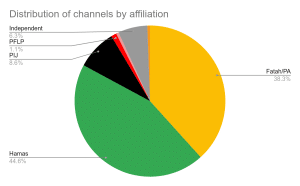
The distribution of members in these channels and groups is as follows:
- 644,686 (26.5%) are members of Fatah-affiliated groups and channels
- 12,756 (0.5%) are members of the Fatah-affiliated channel that opposes Abbas
- 1,001,035 (41.2%) are members of Hamas-affiliated groups and channels
- 394,159 (16.2%) are members of PIJ-affiliated groups and channels
- 17,297 (0.6%) are members of PFLP-affiliated groups and channels
- 1,377 (>0.1%) members of the DFLP-affiliated channel
- 357,549 (14.7%) are members of channels affiliated with independent factions
A total of 2,428,859 members participate in all the channels and groups on which the study focuses.

The average number of members per channel is as follows:
- ~9,622.17 members on average per Fatah-affiliated channel
- ~12,756 members on average per channel affiliated with the Fatah faction that opposes Abbas
- ~12,833.78 members on average per Hamas-affiliated channel
- 26,277.27~ members on average per PIJ-affiliated channel
- ~8,648.5 members on average per PFLP-affiliated channel
- ~1,377 members on average per DFLP-affiliated channel
- ~32,054.45 members on average per channel affiliated with independent factions

Big channels data
Out of the 175 channels and groups there are 46 large channels with over 10,000 members. Of them:
- 15 channels (34.9%) are identified with Fatah
- 1 channel (2.3%) is identified with the Fatah faction that opposes Abbas
- 15 (34.9%) channels are identified with Hamas
- 7 channels (16.3%) are identified with PIJ
- 1 channel (2.3%) identified with PFLP
- 4 channels (9.3%) are identified with independent factions
- DFLP does not have a channel or group with 10,000 or more members.
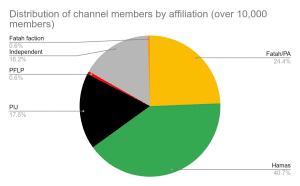
The distribution of members in the big channels and groups is as follows:
- 520,560 (24.4%) members of groups and channels affiliated with Fatah
- 12,756 (0.6%) members of groups and channels affiliated with the Fatah faction that opposes Abbas
- 869,879 (40.7%) are members of groups and channels affiliated with Hamas
- 373,833 (17.5%) are members of PIJ-affiliated groups and channels
- 13,568 (0.6%) members of the PFLP-affiliated channel
- 346,480 (16.2%) are members of channels affiliated with independent factions
A total of 2,137,076 members in all channels and groups on which the research focuses, and to which over 10,000 members are subscribed.
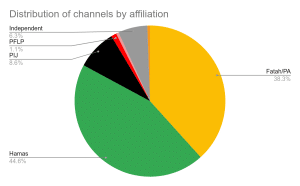
The average number of members per big channel is as follows:
- ~34,704 members on average per Fatah-affiliated channel
- ~12,756 members on average per Fatah-affiliated channel that opposes Abbas
- ~57,991.93 members on average per Hamas-affiliated channel
- 53,404.71~ members on average per PIJ-affiliated channel
- ~13,568 members on average per PFLP-affiliated channel
- ~86,620 members on average per channel affiliated with independent
factions
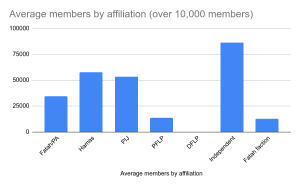
Analysis
Each faction’s distinct strategies have clear effects on the degree of popularity of each of the organizations, with the most popular organizations relatively being the independent ones, both in a general analysis and in the analysis of the major channels only. This is probably due to the fact that the Palestinian public using Telegram supports terrorism against Israel on any possible scale and in any form, and since the independent factions do not represent any religious or political current, no person is pushed aside due to one or another political or religious positions.
Not far behind the independent organizations, the most popular organization in the general channels is PIJ. There are several possible reasons for this, among others the organization’s lack of accountability to population or place in the Palestinian leadership, which positions it in an advantage above factions perceived as “institutional”; its significance in inter-factional unions as well as it being apolitical; or how much the reader enjoys consuming the organization’s content. The fact that the PIJ is less popular than the independent factions can be attributed to being religious, unlike the independent factions which, as mentioned, are not necessarily religious. Another reason could be the PIJ’s almost complete dependence on Iran, which can cause the average Palestinian to dislike the organization for nationalist reasons.
After the PIJ, by a twice as large margin, stands Hamas. A possible reason for this is the number of tiny channels – those with less than 1,000 members – that are affiliated with Hamas. Another reason could be that it is a religio-political organization that rejects both its religious and political opponents.
After Hamas stands Fatah with about 75% of the participants per channel on average compared to Hamas. The reasons for this can be both religious and political, since on the one hand Fatah is not a religious organization but it has an affinity with religion, and on the other hand there is a lot of criticism of it by the management of the PA, something that can naturally cause potential opposers for Fatah.
Looking at the big channels with over 10,000 subscribed members, the picture appears to be slightly different, but the trend still goes against Fatah. As mentioned above, even on the major channels, the independent factions have the most participants on average per channel. In second place is Hamas, and not far behind is the PIJ. The average number of participants in any major channel affiliated with Fatah is less than 60% of that of an average channel affiliated with Hamas.
In the two types of analyzes in question, the most popular political organization is Hamas, followed only by Fatah. PFLP and the DFLP are too small to have an impact on the future of the PA after Abbas’ death, but they are third and fourth respectively in both cases. Hence, the war for control of the Palestinian Authority after the death of Abbas can end with the victory of Hamas and its control of Judea and Samaria in addition to the Gaza Strip, if this is the case and no successor to Abbas is appointed from within Fatah.
Another possibility is the possible military takeover by the independent factions of the districts in which they are located, like criminal organizations, and prevent the Palestinian Authority from entering the areas under their control in fields where they want control, such as terrorism against Israel. This can be seen in Abbas’s visit to Jenin after an operation “Home and Garden”, which only happened after negotiations by a delegation from the PA with senior officials of the Jenin Brigade of the PIJ in order to allow the visit to pass without interference from the local factions, that is despite Abbas being the President of the Palestinian Authority and his arrival with many security forces to secure it. It is likely that in the event that the independent factions take control of the PA territories militarily, they will allow the PA to operate in their territories in the areas of management and logistics, and they will replace the PA’s security mechanisms – the power will be with those factions, but the responsibility be on the PA.
Interesting angles – Telegram / Real life comparison
The official Fatah channel in the Bethlehem area has approximately 4,500 subscribed users, while its counterpart from Hamas only has approximately 380 subscribed users. At Bir Zeit University, unlike Bethlehem, you can see a sentiment that leans more toward Hamas: the channel of the student movement of Fatah – “Shabiba” – in Bir Zeit has approximately 940 subscribed users, compared to the channel of the student movement of Hamas, which has approximately 5,050 subscribed users.
It is apparent that in the largest channels, those with hundreds of thousands of subscribers, such as the official channel of Hamas’s Izz ad-Din al-Qassam Brigades with over 200,000 subscribed users, the independent Lion’s Den with almost 250,000 subscribed users, or PIJ’s Jerusalem Brigades with approximately 140,000 subscribed users, the language is often done in a much more elegant way than the other forums, even those that are not particularly small. There are two types of messages in channels of this kind – long and eloquent messages called Bayan (plural – bayanat, translated as “announcement” or “proclamation”), and sometimes news updates in a higher level language than is customary in other Telegram channels. Fatah does not have such a channel apart from official channels of the Palestinian Authority, to which people may subscribe out of a desire or need to be updated, rather than support, and the biggest of which does not pass 15,000 subscribers. Fatah channels sometimes issue such statements, but they do not put a special emphasis on it like other organizations.
These announcements, combined with the relevance of the organizations, can be the reason for those channels having so many members, since users will probably prefer to read a coherently written message over a short and unclear message, which sometimes will even include spelling mistakes, as sometimes happens in other channels. The relevance of the organization greatly affects the channel’s popularity as well, since PFLP and DFLP issue statements almost daily, but since they are not politically relevant like Fatah or Hamas, or militarily like PIJ and the independent factions, despite the statements they do not manage to gain broad support on Telegram like the others.
The seemingly apolitical character that characterizes PIJ and the independent factions is not unique to it. The largest Palestinian channel, “Jenin Al-Qassam”, is engaged in unaffiliated news coverage of terrorism in Jenin and has over 360,000 subscribed users. This channel is not included in the statistics due to being a news channel that is not affiliated with any faction. Despite being unaffiliated, its owner, Ali al-Ghoul, was a 17-year-old Hamas operative. Al-Ghoul was killed in Operation “Home and Garden” on 02 July 2023. The channel gained over 55,000 subscribers within a month of Al-Ghoul’s death. Apparently, when it became known that al-Ahul owned the channel, many users signed up to it, and it is possible that this was done as a tribute to the “Martyr” after his death. Along with the news that al-Ghoul was the owner of the channel until his death, his organizational affiliation was also revealed, and it should be noted as a possible cause to the rapid growth of the channel after his death.
TikTok
Due to increased content moderation on Facebook and Twitter, content affiliated with Fatah and Hamas exists, albeit scarce. Not only do many of the users and groups affiliated with extremist content closed or suspended shortly after their creation, the content that remains suffers extremely poor engagement, with few likes and shared even in profiles that enjoy hundreds of thousands of followers. This could indicate the popularity of these platforms in the Palestinian society when it comes to politics.
However, on Tiktok there seems to be wide-scale and authentic involvement of Palestinians. Content supporting and slandering each of the two movements, Fatah and Hamas, gains hundreds of thousands of views, even reaching over a billion views. While many Israelis perceive Tiktok as an entertainment platform for the younger generation, it is viewed as a political hub among Palestinians.
TikTok’s popularity among young Palestinians is evidenced by the fact that the “Guardian of the Walls” events were accompanied by videos uploaded by young Palestinians and Israeli Arabs documenting their participation in nationalist incidents against Jews. Such was the TikTok “trend” of attacking ultra-Orthodox youth on the streets of Jerusalem and on the light rail.
TikTok has also fostered the popularity of the Lions’ Den terrorist group, and of “freelance” terrorists such as Ibrahim Nabulsi, who thrived as he uploaded documentation of terror attacks against Israelis on TikTok. This turned him into a star, and inspired some young Palestinians to follow suit.
What can we learn from TikTok on the popularity of different Palestinian factions?
Comparative analysis of Hamas- and Fatah-affiliated hashtags
Methodology:
- Comparative analysis of the popular hashtags associated with Hamas and Fatah, segmented by the number of views in the last year and in general, the number of posts in the last year and in general, and age groups.
Key findings
- When analyzing posts as per Hamas- and Fatah-affiliated hashtags, the data shows clear advantage for Hamas on TikTok over Fatah, in particular among the youngest age group of 18-24. On top of that, Lions’ Den, a relatively new and non-official armed group with far less maturity than that of well-established Palestinian factions such as Hamas and Fatah gains massive support which even exceeds Fatah’s.
- Hamas holds a clear advantage over Fatah in terms of the number of posts with Hamas-affiliated hashtags with 12.6 more posts in the past year – June 2022 to June 2023 (151,641 as opposed to 11,947) and 6.9 more posts in total (415,692 as opposed to 59,847).
- Considering the number of views, Fatah holds an advantage over Hamas when analyzing the total number of views with 135.8 million views of Fatah-affiliated videos as opposed to 102.1 million views of Hamas-affiliated videos. However, this trend turns opposite way when considering the number of views in the past year – June 2022 to June 2023, with 2.25 more views of Hamas-affiliated videos (1.7 billion as opposed to 753.6 million).

Hamas vs Fatah-affiliated hashtags on TikTok by number of posts
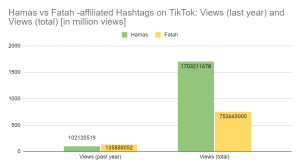
Hamas vs Fatah-affiliated hashtags on TikTok by number of views
- In addition, Hamas-affiliated hashtags enjoy more popularity among the youngest and have the least popularity among the oldest.
- Among the 18-24 age group, Hamas’s share is 37.96% higher than Fatah’s, with 21.66% of its video views originating in this age group as opposed to 15.7% among Fatah videos.
- Among the 25-34 age group, Hamas’s share is slightly larger than Fatah’s, with 69.63% of its video views originating in this age group as opposed to 65.61% among Fatah videos.
- Among the 35+ age group, Fatah’s advantage is clear – 67% higher than Hamas’, with 14.76% of its video views originating in this age group as opposed to 8.69% among Hamas videos.
- It is to be noted that TikTok does not enable analyzing engagement among users younger than the age of 18.
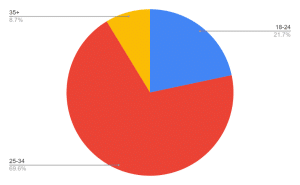
Segmentation of Hamas-affiliated hashtags on TikTok by age group
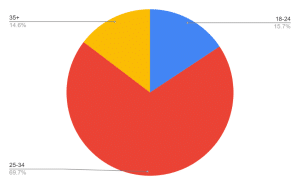
Segmentation of Fatah-affiliated hashtags on TikTok by age group
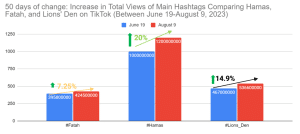
Tiktok – comparative analysis of increase in views of videos with the hashtag #Hamas, #Fatah and #Lions_Den during the 50 days between June 19 and August 9, 2023, Tiktok
Comparative analysis of engagement gained by Hamas- and Fatah-affiliated content as per combination with geographic areas-related hashtags (location tags)
Terminology
View count: In the context of TikTok, the term “view count” refers to the numerical representation of the total number of times a video has been viewed by users. Each time a user opens and watches a video, the view count increases by one. This metric provides insights into the popularity and reach of a particular video, helping content creators and researchers gauge the level of audience engagement and the overall impact of the content on the platform.
Like count: The “like count” on TikTok represents the total number of times users have expressed appreciation for a video by tapping the heart-shaped “like” button. This action indicates that the viewer enjoyed the content and serves as a measure of positive engagement. The like count helps content creators assess the reception of their videos and contributes to TikTok’s algorithm, influencing the likelihood of the video being recommended to a wider audience.
Comment count: The “comment count” denotes the total number of user-generated comments posted in response to a specific TikTok video. Comments provide a platform for users to interact with the content creator and other viewers, allowing for discussions, feedback, and community engagement. Higher comment counts can indicate that a video has sparked significant interest or has resonated with the audience on a deeper level.
Share count: In the TikTok context, the “share count” reflects the number of times users have redistributed or re-shared a particular video on their own TikTok accounts or other social media platforms. When users come across content they find compelling, they can share it with their followers, friends, or broader networks, amplifying the video’s reach beyond its original audience. The share count serves as an indicator of how shareable and viral a video may be, showcasing its potential for widespread dissemination.
Save count: The “save count” pertains to the total number of times a video has been saved by TikTok users to their personal collections. The “save” feature allows users to bookmark videos they find interesting or valuable for future reference, re-watching, or sharing with others. The save count is an essential metric that helps content creators understand the long-term impact and enduring appeal of their videos, as well as the level of audience investment in preserving and revisiting the content.
Bot: In the context of TikTok and other social media platforms, a “bot” refers to an automated software application or script that operates with minimal human intervention. These bots are designed to perform specific tasks repeatedly and at high volumes, often mimicking human behavior. When discussing bots in the context of TikTok, it typically pertains to spamming videos with artificial engagement, or repeatedly uploading the same video in order to spam search results, thus skewing any metrics.
Methodology
To conduct the analysis of data from TikTok related to Hamas and Fatah, a multi-faceted methodology is employed. The first step involves data collection, where hashtag combinations affiliated with both organizations are systematically retrieved from the TikTok platform. This process ensures a comprehensive dataset representing the content associated with Hamas and Fatah. The combination of generic hashtags ensures a content analysis that is focused on Fatah and Hamas, and avoiding “dumpster” results by combining generic keywords (e.g. “shabiba”/“youth” or “kutlatna”/“our list”) with geographical locations (e.g. Bethlehem, Jenin, etc.).
Next, a general analysis of the collected data is performed, focusing on key metrics such as views and engagement indicators, including likes, comments, shares, and saves. These metrics provide valuable insights into the popularity and interaction level of the content related to the targeted groups. This analysis aids in understanding the trends, preferences, and content dynamics associated with Hamas and Fatah on TikTok.
Subsequently, a more specific analysis based on geographic location is conducted. By leveraging location hashtags from TikTok posts, the content’s popularity and engagement are examined across different regions. This geographical segmentation allows for a deeper understanding of how the content resonates with specific audiences in different locations, identifying potential regional variations in interest and engagement patterns.
Overall, this comprehensive methodology combines data collection, general analysis, and location-based insights to provide a holistic view of the TikTok content related to Hamas and Fatah. The findings from this study contribute to a better understanding of the organizations’ presence and impact on the platform and offer valuable insights for researchers interested in these communities and their interactions on TikTok.
Data
General data
The analysis is based on 19,122 videos. Out of these videos:
- 9,055 (47.4%) are affiliated with Fatah
- 10,067 (52.6%) are affiliated with Hamas
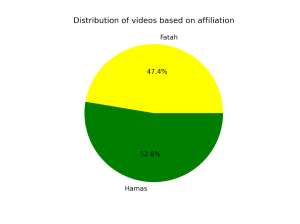
The average number of views per affiliation is as follows:
- 238,864.78 views per video affiliated with Fatah
- 301,418.14 views per video affiliated with Hamas
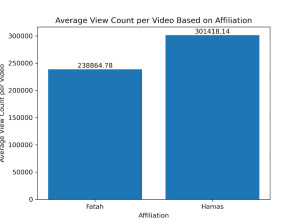
The average number of likes per affiliation is as follows:
- 9,320.28 likes per video affiliated with Fatah
- 10,394.66 likes per video affiliated with Hamas

The average number of comments per affiliation is as follows:
- 08 comments per video affiliated with Fatah
- 75 comments per video affiliated with Hamas
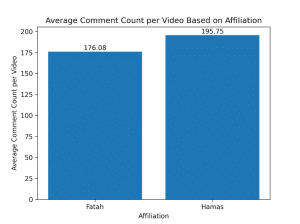
The average number of shares per affiliation is as follows:
- 18 shares per video affiliated with Fatah
- 08 shares per video affiliated with Hamas
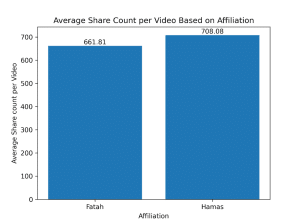
The average number of saves per affiliation is as follows:
- 19 saves per video affiliated with Fatah
- 52 saves per video affiliated with Hamas
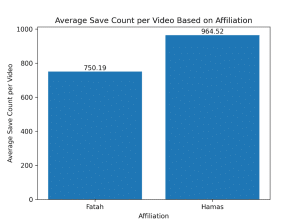
Data as per location tags
General distribution by location and affiliation:
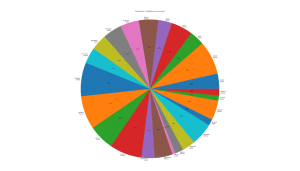
Average view count per location:
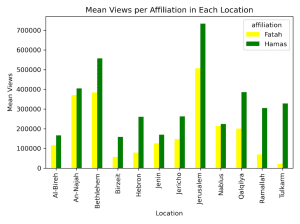
Average like count per location:
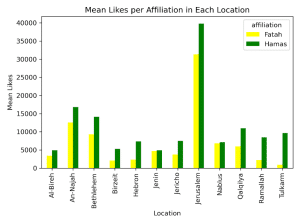
Average comment count per location:
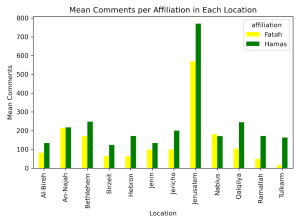
Average share count per location:
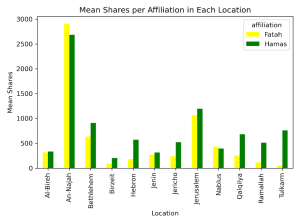
Average save count per location:
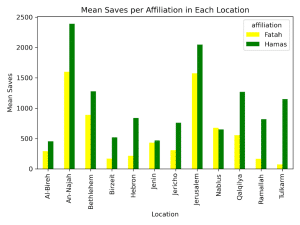
Please see Appendices A and B for the full geotag-based data and analysis.
Outlook at the results of the Bir Zeit University’s student association election – 2007-2023
Over the past 19 years, no presidential or parliamentary elections have been held among Palestinians. The only frameworks that have been facilitating elections were municipalities – where in some cases the results are dependent on agreed-upon candidates representing certain ethnicities or clans – and the universities. This litmus test attests more than any poll on the trends in popularity of the main Palestinian political factions, Hamas and Fatah, represented by means of their respective student groups, “Kutla Islamia” and “Shabiba” (Kutlat Al-Shahid Yasser Arafat), alongside other, much more marginal groups.
Elections for the student association are held annually in all Palestinian universities. The Birzeit University case study attests to the level of popularity of a once-firm Fatah stronghold, where Hamas has reclaimed solid and consistent majority over the past several years. In 2009-2010 Hamas refused to participate in the election, citing corruption and marginalization. In 2020-2021 no election has been held due to the covid-19 pandemic.
Hamas has gained clear victories in all student association elections held since 2015, except the tied result in 2019. It is to be noted that these accomplishments have been obtained in spite of the Palestinian Authority’s efforts to undermine Hamas’ student groups in fear of a questioning the PA rule in A and B territories around Judea and Samaria, especially in light of the 2007 Gaza coup d’état. The PA has done that by means of, inter alia, arrests of student activists, raids on their facilities and possible irregularities. Israel has also arrested on a number of occasions “Kutla” activists following intelligence indicating their ties to terrorism.
It is worth mentioning that elections for the universities’ student associations are not necessarily representative of political trends among the general population. Students are often associated with more educated or affluent population groups. They tend to be younger and prone to political influence. However, campuses are precisely where revolutions and major political movements have historically thrived. Both Chairman Abbas and Hamas senior official Haniyyeh identified their potential, and cited universities as a major battlefield to win hearts and minds. Major arch-terrorists such as Yahia Ayash and Marwan Barghouti are alumni of the Birzeit University and were politically active over the course of their studies there.
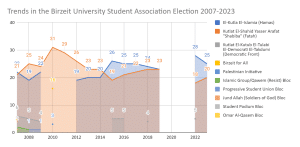
IDSF Index – The Day After Abbas
The stability of the PA following President Mahmoud Abbas (Abu Mazen)’s retirement is a question that affects the security coordination between Israel and the PA, and naturally on the viability of future negotiation with the Authority. Instability would hold off any sustainable agreements.
Only a minority (9%) of the Israeli public thinks that after Mahmoud Abbas’s rule, the transfer of power will occur in an orderly manner. 35% think Hamas will take over the Palestinian Authority in effect; 28% predict anarchy in the Palestinian Authority, forcing the State of Israel to intervene militarily, and 28% did not answer as they felt they do not know what will happen in the Palestinian Authority with the end of Mahmoud Abbas’s rule.
A segmentation of the responses shows that the Jewish public as well is uncertain about what the day after Abu Mazen holds: 5% believes that the transfer of power will proceed in an orderly fashion; nearly a third (28%) maintain that anarchy will break out in the PA forcing Israel to intervene militarily; 20% think that Hamas in effect will take control; 21% predict a coup or military takeover of Judea and Samaria by Hamas, and 26% replied “I don’t know”.
The situation among Israeli Arabs does not paint a dramatically different picture: almost a third (28%) of Israeli Arabs foresee anarchy in the Palestinian Authority with the State of Israel forced to intervene militarily; 17% predict a transfer of power in effect to Hamas; 18% think that Hamas will affect a coup or military takeover of Judea and Samaria, and only 9% think there will be an orderly transfer of power (28% answered “I don’t know”).
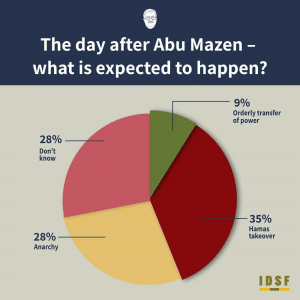
In such a state of uncertainty characterizing the near future of the PA’s security and politics, it is to be expected that the State of Israel would be well prepared for what the future might bring. However, the Israeli public does not believe it is: over half (52%) of the public deem Israeli unprepared for the eventualities of the day after Abu Mazen; approximately a third (28%) of the respondent did not know, and only 20% was confident of Israeli preparedness.
The survey was conducted by the IDSF research department and with statistical guidance from Dr. Hagai Elkayam. The sample was conducted among 1,191 respondents from the adult population (18+) in Israel who use the Internet. For the Jewish sample (956 respondents), the maximum margin of error is ±3.17% with a probability of 95%; For the combined sample (1,191 respondents), the maximum margin of sampling error is ±2.84% with a 95% probability; For the Arab sample (235 respondents), the maximum margin of error is ±6.39% with a probability of 95%.

PCPSR Opinion Poll Compilation
Public opinion polls provide another angle that teaches about the moods on the Palestinian street in preparation for the day after Abbas. The Ramallah-based Palestinian Institute for Policy Survey Research (PCPSR) is one of the important sources in this context. PCPSR describes itself as an independent research institute and non-profit institution whose goal is policy analysis and academic research in the context of Palestinian society – domestic politics and governance, strategic analysis and foreign policy, and public opinion polls and survey research. The institute is managed by Dr. Khalil Shkaki, who holds a PhD from Columbia University; its board of directors includes Dr. Modar Kassis, program director and research fellow at Bir Zeit University, Dr. Yazid Sayeh from the Carnegie Center for Middle East Studies in Beirut, and Dr. Azmi Al-Shu’aibi, senior at the Palestinian Research Institute AMAN for the Study of Corruption and former council member The Palestinian legislature.
We exclusively analyzed the results of the PCPSR public opinion polls on a 5-year timeline: every quarter between 2021-2023 and every year between 2020-2018. An analysis of the survey trend sheds light on the significant trends on the Palestinian street in the context of the day after Abbas:
Domestic Politics: Fatah vs Hamas, PA’s Popularity, Demanding Abbas’s Resignation
Do you support the holding of presidential and legislative elections in the Palestinian territories in the near future?
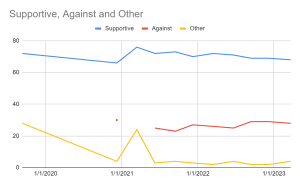
Do you believe any legislative, or legislative and presidential, elections will take place soon?
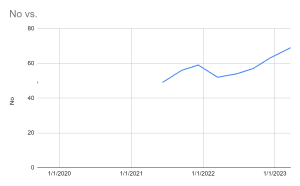
Level of satisfaction with the performance of president Abbas
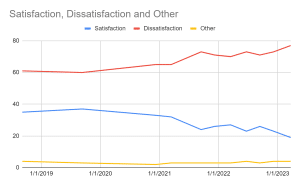
Do you want President Abbas to Resign?
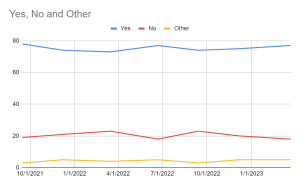
Who is most deserving of representing and leading the Palestinian people?

If new legislative elections were held today with the participation of all factions that participated in the 2006 elections, which list will you vote for?
*Notice May 2021 – Guardian of the Walls
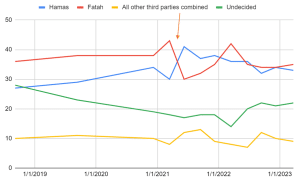
Perception of corruption in PA institutions
Yes:
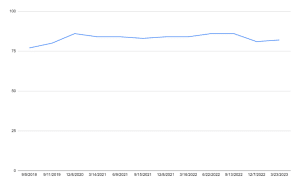
Assessment of the PA
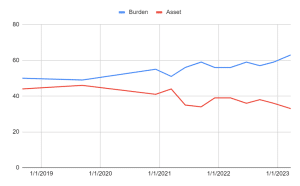
Election results
If new presidential elections were held today and only two were nominated, whom will you vote to?
*Notice May 2021 here as well
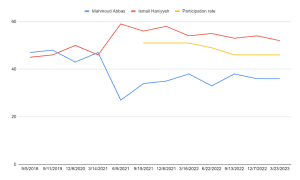
Between Mahmoud Abbas and Ismail Haniyyeh
“West bank”
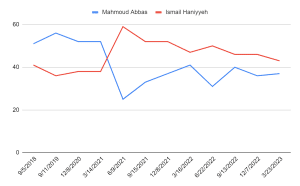
Between Marwan Barghouti and Ismail Haniyyeh
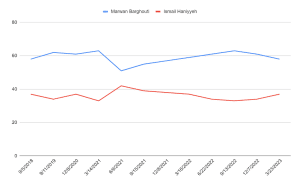
Between Prime Minister Mohammad Shtayyeh and Ismail Haniyyeh
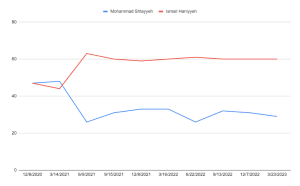
If Abbas does not run for elections, whom will you prefer as successor? (close-ended question)
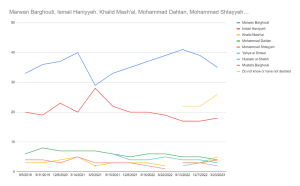
Israeli-Palestinian Conflict
Support for the concept of the two-state solution
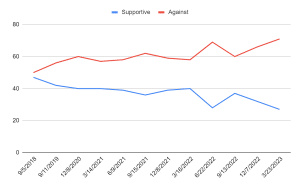
What are the chances for the creation of a Palestinian state alongside the state of Israel in the next five years?
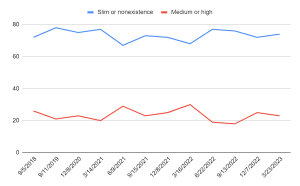
What are the most effective means of ending “the Israeli occupation” and building an independent state?
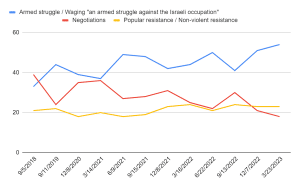
The most preferred way out of the current status quo
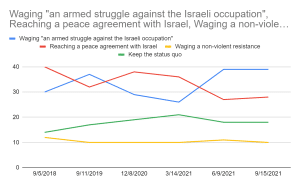
What is the most pressing problem confronting the Palestinians today?
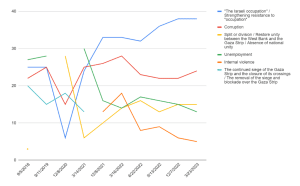
Multi-choice: Support for specific policy choices to break the current deadlock
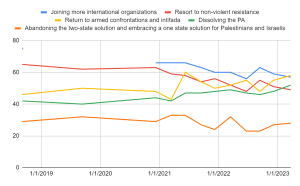
Armed Groups
Support of the formation of armed groups, such as the “Lions’ Den”
| 3/23/2023 | 12/7/2022 | |
| Supportive | 68 | 72 |
| Against | 25 | 22 |
Does the PA have the right to arrest member of these armed groups in order to prevent them from carrying out attacks against Israel or to provide them with protection?
| 3/23/2023 | 12/7/2022 | |
| Yes | 8 | 10 |
| No | 87 | 87 |
PA’s Security Coordination with Israel
Supportive of the ending of security coordination with Israel that was announced recently by the PA
| 3/23/2023 | 3/16/2022 | 12/8/2020 | |
| Supportive | 63 | 61 | 53 |
| Against | 32 | 44 |
